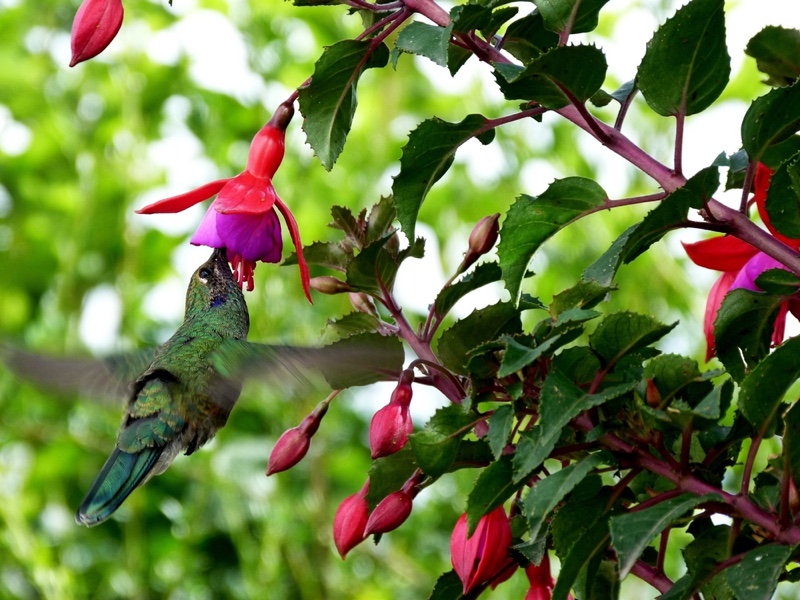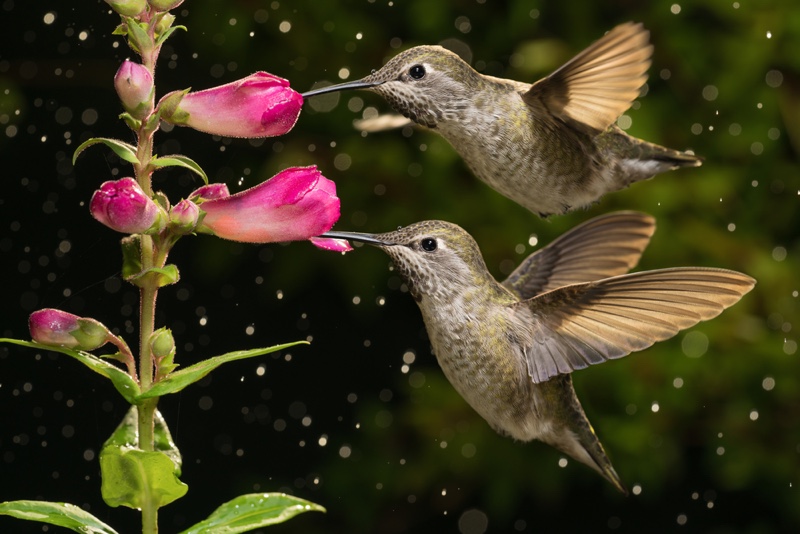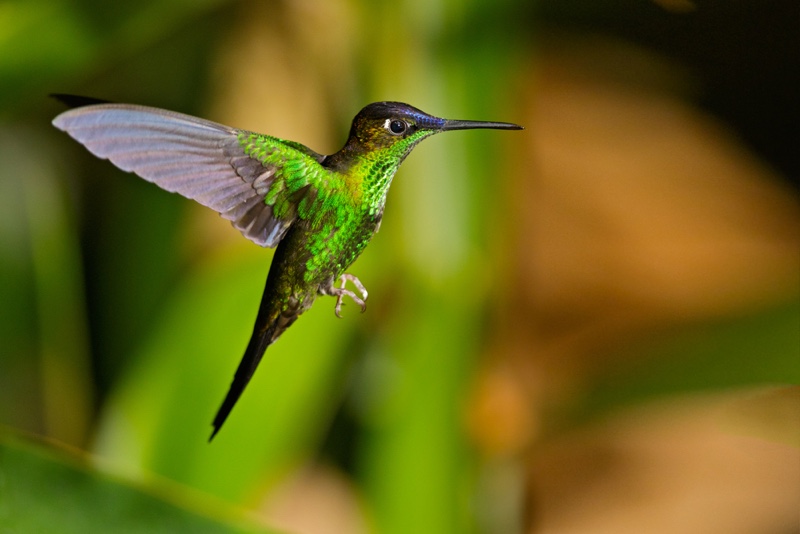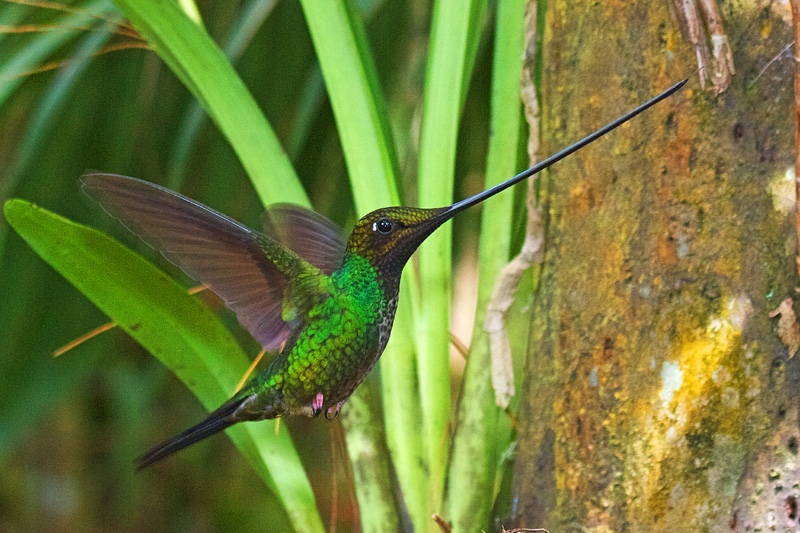An Argument: Hummingbirds Are the Best Pollinators
Several ways in which these super sick birds are great.
An Argument: Hummingbirds Are the Best Pollinators
Several ways in which these super sick birds are great.

This is not meant to disparage bees, which can pollinate thousands of flowers per day, create honey, and, according to experts, are the world’s smartest bug. What I am here to talk about today is just how great hummingbirds are. Here are some of the ways in which hummingbirds are truly sick pollinators (and birds, in general).
Hummingbirds pollinate flowers no other animal can.

Hummingbirds boast long, thin beaks, which allow them to get deep into the interiors of flowers that even large bees may not be able to spelunk. Whether the hummingbird evolved to take advantage of these flowers or the flowers evolved to take advantage of the hummingbirds (or both), the fact remains that hummingbirds can tackle the most forbidding of flowers.
They collect pollen in very adorable ways.

Bees spread pollen when it sticks to the hairs on their bodies and rubs off on other flowers. Good method! But hummingbirds are even cuter. They transfer pollen when it sticks to their beaks or their adorable tiny foreheads. Look at that little guy! Haha!
They don’t damage flowers.

Lots of animals pollinate flowers, but the larger ones can sometimes cause unexpected damage. For example: Lemurs, rodents, and possums all serve as pollinators, mostly by getting pollen stuck in their fur, but these bigger, heavier animals can sometimes damage a plant. Not hummingbirds! Hummingbirds are delicate creatures that rarely land; their feet are tiny and weak, so they primarily just hover next to flowers while eating. How gentle!
They have some extremely sick names.

Hummingbird species are separated into clades, which are basically different categories of birds. Most animals are divided into clades; this is not unusual. What makes hummingbird clades so fun is that they’re named for how the hummingbird looks, and hummingbirds look extremely cool. The bird above, for example, is in the “Brilliant” clade. Other clades include “Topaz,” “Mango,” “Gem,” and “Emerald.”
They have insane beaks like this.

This right here is the sword-billed hummingbird, which lives in mountainous regions of western South America. It is the only bird species to have a bill longer than its body. It usually feeds on flowers with very deep chambers, but it can also, despite its very long bill, feed from short feeders, too. The Internet Bird Collection has some great videos of this hummingbird if you’re interested, and we assume you are interested, so go check it out.
Hummingbirds can imitate songs.
It’s not widely known, but hummingbirds are very vocal and can be territorial and aggressive when around food sources. They’re one of only a few species that have shown the capability of “vocal learning,” which is the ability to imitate new vocalizations. Parrots and songbirds are the only other bird species to have this ability, a skill that’s shared with only humans, whales, dolphins, seals, elephants, and bats. Not even non-human primates can do this!
In conclusion, hummingbirds are extremely good birds and awesome pollinators. Thank you.
Follow us
This work is licensed under a Creative Commons Attribution-NoDerivatives 4.0 International License.
Want to republish a Modern Farmer story?
We are happy for Modern Farmer stories to be shared, and encourage you to republish our articles for your audience. When doing so, we ask that you follow these guidelines:
Please credit us and our writers
For the author byline, please use “Author Name, Modern Farmer.” At the top of our stories, if on the web, please include this text and link: “This story was originally published by Modern Farmer.”
Please make sure to include a link back to either our home page or the article URL.
At the bottom of the story, please include the following text:
“Modern Farmer is a nonprofit initiative dedicated to raising awareness and catalyzing action at the intersection of food, agriculture, and society. Read more at <link>Modern Farmer</link>.”
Use our widget
We’d like to be able to track our stories, so we ask that if you republish our content, you do so using our widget (located on the left hand side of the article). The HTML code has a built-in tracker that tells us the data and domain where the story was published, as well as view counts.
Check the image requirements
It’s your responsibility to confirm you're licensed to republish images in our articles. Some images, such as those from commercial providers, don't allow their images to be republished without permission or payment. Copyright terms are generally listed in the image caption and attribution. You are welcome to omit our images or substitute with your own. Charts and interactive graphics follow the same rules.
Don’t change too much. Or, ask us first.
Articles must be republished in their entirety. It’s okay to change references to time (“today” to “yesterday”) or location (“Iowa City, IA” to “here”). But please keep everything else the same.
If you feel strongly that a more material edit needs to be made, get in touch with us at [email protected]. We’re happy to discuss it with the original author, but we must have prior approval for changes before publication.
Special cases
Extracts. You may run the first few lines or paragraphs of the article and then say: “Read the full article at Modern Farmer” with a link back to the original article.
Quotes. You may quote authors provided you include a link back to the article URL.
Translations. These require writer approval. To inquire about translation of a Modern Farmer article, contact us at [email protected]
Signed consent / copyright release forms. These are not required, provided you are following these guidelines.
Print. Articles can be republished in print under these same rules, with the exception that you do not need to include the links.
Tag us
When sharing the story on social media, please tag us using the following: - Twitter (@ModFarm) - Facebook (@ModernFarmerMedia) - Instagram (@modfarm)
Use our content respectfully
Modern Farmer is a nonprofit and as such we share our content for free and in good faith in order to reach new audiences. Respectfully,
No selling ads against our stories. It’s okay to put our stories on pages with ads.
Don’t republish our material wholesale, or automatically; you need to select stories to be republished individually.
You have no rights to sell, license, syndicate, or otherwise represent yourself as the authorized owner of our material to any third parties. This means that you cannot actively publish or submit our work for syndication to third party platforms or apps like Apple News or Google News. We understand that publishers cannot fully control when certain third parties automatically summarize or crawl content from publishers’ own sites.
Keep in touch
We want to hear from you if you love Modern Farmer content, have a collaboration idea, or anything else to share. As a nonprofit outlet, we work in service of our community and are always open to comments, feedback, and ideas. Contact us at [email protected].by Dan Nosowitz, Modern Farmer
June 22, 2017
Modern Farmer Weekly
Solutions Hub
Innovations, ideas and inspiration. Actionable solutions for a resilient food system.
ExploreExplore other topics
Share With Us
We want to hear from Modern Farmer readers who have thoughtful commentary, actionable solutions, or helpful ideas to share.
SubmitNecessary cookies are absolutely essential for the website to function properly. This category only includes cookies that ensures basic functionalities and security features of the website. These cookies do not store any personal information.
Any cookies that may not be particularly necessary for the website to function and are used specifically to collect user personal data via analytics, ads, other embedded contents are termed as non-necessary cookies.
I thoroughly enjoyed your fascinating article- loved your unique voice- “appeals to the young ones as well as the young at heart”. I particularly greatly admired your photographs. I was wondering if the photos are copyrighted and permission etc. is needed to use them. My reason for asking is that I was supposed to be participating with my City, which was just designated a Pollinator City, in a Pollinator Week Kick-Off in June, which naturally was cancelled. Seeing that I am children’s author and illustrator, the City asked me to create an activity booklet for kids the important role of… Read more »